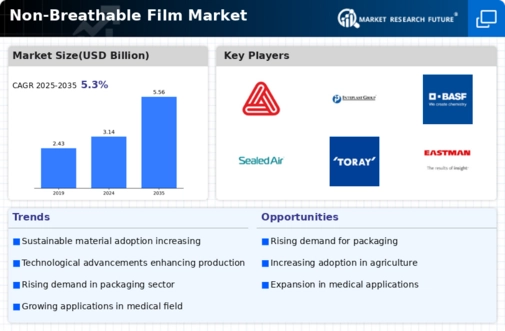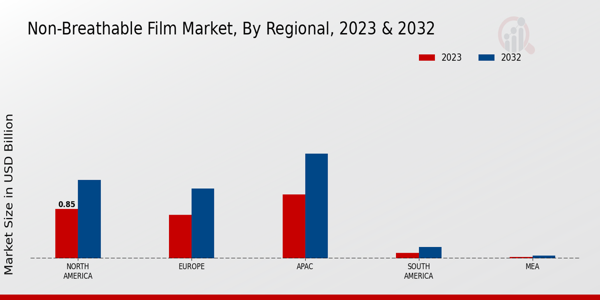Market Growth Projections
The Global Non-Breathable Film Market Industry is projected to experience robust growth over the next decade. With a compound annual growth rate (CAGR) of 5.33% anticipated from 2025 to 2035, the market is expected to expand significantly. This growth trajectory is driven by various factors, including increased demand across multiple sectors, technological advancements, and evolving consumer preferences. As the market evolves, stakeholders are likely to witness substantial opportunities for investment and innovation, positioning non-breathable films as a vital component in various applications.
Growth in Healthcare Applications
The Global Non-Breathable Film Market Industry is significantly influenced by the growth in healthcare applications. Non-breathable films are extensively used in medical packaging, wound care products, and personal protective equipment. The increasing focus on hygiene and safety in healthcare settings has led to a rising demand for reliable packaging solutions that ensure product sterility. As the healthcare sector expands, particularly in emerging markets, the need for non-breathable films is likely to grow. This trend is expected to contribute to the market's overall expansion, with projections indicating a market value of 5.56 USD Billion by 2035, highlighting the importance of non-breathable films in healthcare.
Rising Demand in Packaging Sector
The Global Non-Breathable Film Market Industry experiences a notable surge in demand driven by the packaging sector. Non-breathable films are increasingly utilized in food packaging, pharmaceuticals, and consumer goods due to their moisture barrier properties. This trend is particularly evident as the market is projected to reach 3.14 USD Billion in 2024, reflecting a growing preference for products that enhance shelf life and maintain product integrity. As sustainability becomes a focal point, manufacturers are innovating to create eco-friendly non-breathable films, further stimulating market growth. The packaging industry's expansion is likely to continue fueling the demand for non-breathable films in the coming years.
Increasing Urbanization and Consumerism
Urbanization and rising consumerism are pivotal factors driving the Global Non-Breathable Film Market Industry. As urban populations grow, there is a corresponding increase in demand for packaged goods, which often utilize non-breathable films for protection and preservation. This trend is particularly pronounced in developing regions, where changing lifestyles and increased disposable incomes lead to higher consumption of packaged products. The shift towards convenience and ready-to-eat meals further propels the need for effective packaging solutions. Consequently, the market is poised for growth, as urbanization continues to reshape consumer behavior and preferences.
Regulatory Support for Sustainable Practices
Regulatory support for sustainable practices is emerging as a significant driver in the Global Non-Breathable Film Market Industry. Governments worldwide are implementing policies that encourage the use of eco-friendly materials and sustainable production methods. This regulatory landscape is prompting manufacturers to innovate and develop non-breathable films that align with environmental standards. As consumers increasingly favor sustainable products, companies that adapt to these regulations may gain a competitive edge. The emphasis on sustainability is likely to influence market dynamics, fostering growth in the non-breathable film sector as it aligns with global environmental goals.
Technological Advancements in Film Production
Technological advancements play a crucial role in shaping the Global Non-Breathable Film Market Industry. Innovations in polymer science and manufacturing processes have led to the development of high-performance non-breathable films that offer enhanced durability and functionality. These advancements enable the production of films with superior barrier properties, catering to diverse applications across various industries. As companies invest in research and development, the introduction of new materials and techniques is expected to drive market growth. The continuous evolution of production technologies may also lead to cost reductions, making non-breathable films more accessible to a wider range of consumers.




















